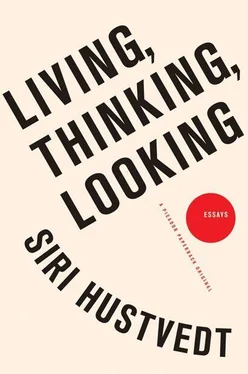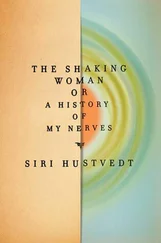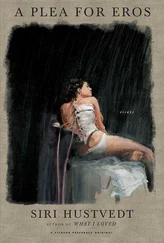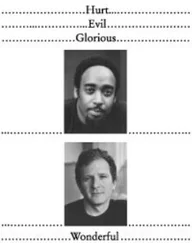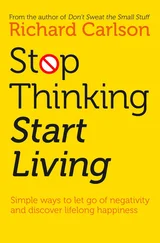Producing art includes a drive to make something, an embodied intentionality. But art is not possible without intersubjective human experience because art is always a gift made for another, not a specific other, but a generalized other person who is asked to read or listen or look. Art necessarily establishes a relation between the artist and an imaginary reader, viewer, or listener; it is inherently dialogical. Therefore, all visual art implies a spectator , even when that other is part of the self, the viewing self, as was the case with Henry Darger, one of the so-called outsider artists. When he died in Chicago in 1973, he left behind him the immense illustrated saga of the Vivian girls, over fifteen thousand pages of narrative and several hundred watercolors that include hermaphroditic girl armies and their often violent adventures. He was his own voyeur.
The artist presses something of himself out into the world — the fantasies of a man bruised forever by his childhood. Darger’s mother died when he was four. Then he lost his crippled father, and the boy, deemed defective, was sent to a mental institution, from which he escaped when he was sixteen. In his art, he created an epic of children enslaved by sadistic adults, a narrative of suffering and insurrection that finally ends in triumph. And the story and the pictures are at once of him and not of him. Darger was an urban hermit. It is doubtful that he spent much time in art museums, but his pictures draw from visual representations he knew well: advertisements, comics, and illustrations from children’s books. I am using Darger as an example, but what I am going to say is true of every artist, for this is where inside and outside collapse. No artist lives in a vacuum, not even Henry Darger. The perceived world becomes part of us in memory, but we are also immersed in that world. Much of what we take in becomes part of our vast implicit understanding of things once it is learned, becomes the body’s knowledge, and this knowledge can’t be separated from our engagement with people and things in our particular environment.
When I am drawing my self-portrait I do not think about where my hand is on the paper; it moves because I know how to move it. My hand responds automatically to what I am seeing in the mirror. I don’t rehearse drawing any more than I relearn how to ride a bike every time I jump on one. I might mourn my skills and wish I were Leonardo da Vinci, but what I am able to do is present in my hand’s motion. Living is movement. Thoughts are in motion, and when I think, my body thinks too. While writing I find the words not only in my mind but in the feeling of my fingers on the keyboard. When I’m stuck, I stand up and walk around the room, and walking often jogs the sentence loose. There is a powerful connection between vision and motor-sensory circuits in the brain, and visual perception cannot be separated from our knowledge of the world gained through our movements in it.
We are proprioceptive beings. Broadly, proprioception, which comes from the Latin word proprius, meaning one’s own, is our ability to sense the position, orientation, and movement of our bodies and its parts in space. Much of the time we simply don’t have to think about this; it is unconscious. As with so many things we take for granted, it is only when this sixth sense doesn’t develop or is lost to injury that its absolute necessity is made clear. Children with a defective proprioceptive sense may fall down or intentionally bump into walls and doors to get a better idea of where they are. People who suffer a brain injury and damage this faculty cannot feel where their bodies are in relation to a chair, for example, and will have to actively evaluate their spatial relation to it in order to sit down.
If you are throwing up your hands and saying, “But what does this have to do with art?” my answer is that every encounter with a work of art is an embodied, subjective one. Our phenomenal experiences of Duchamp, Kosuth, Richter, or Darger are not objective, third-person experiences. I don’t fly out of my body and my personal story when I stand in front of Duccio’s Madonna and Child at the Metropolitan Museum. What happens happens between me and the image. Even in science there is no such thing as perceptual neutrality. 13This doesn’t mean that looking at art is a solipsistic experience either or that any response is as good as another. I can imagine flying out of my body and examining the picture from another perspective, say as an old childless man, but I know that my excursion is not real. I can also use my learning about painting in Siena at the turn of the fourteenth century to inform my vision. We cannot help but be part of our language and culture, which shape our beliefs about how things are. And we all engage to one degree or another in consensus-making, and intersubjective consensus precedes us. Nevertheless, we all have a genetic makeup — some scientists call it temperament — that will be expressed through our environments. The temperamentally sensitive will be more vulnerable to shocks and blows than the temperamentally robust. This applies to art as well. Our temperaments in tandem with our personal stories as we grow as human beings will affect our responses to a painting and become part of the dialogue.
We are born into meanings and ideas that will shape how our embodied minds encounter the world. The moment I walk through the doors of the Prado or the Louvre, for example, I enter a culturally sanctified space. Unless I am an alien visitor from another galaxy, I will be permeated by the hush of greatness, by a sense that what I am going to see has the imprimatur of those in the know, the experts, the curators, the culture-makers. This idea of grandeur made physical by big rooms, rows of paintings and sculptures, affects my perception of what I am going to see. An expectation of greatness is apt to be part of my perception, even if I consider myself unprejudiced and am not aware that my view of a work of art has been subtly altered by where it is.
Art’s meaning is created at every level of our experience. Sensing color, for example, appears to be prereflective. Red, green, or blue will affect us — we will feel their impact — before we are even able to name the color. As the Gestalt theorists argued, we will also distinguish foreground from ground prior to a recognition of the objects on that ground. This has been called “preattentive” vision. 14A large work of art will immediately strike us, as will a very small one, before we can articulate largeness or smallness because, if our proprioceptive sense is working, we will engage with its size instantly, before we can meditate on it. And, I think what we see has emotional or affective value, not after we have contemplated the object and named it, but in the earlier subliminal stages of vision. In an article “See It with Feeling: Affective Predictions during Object Perception,” L. F. Barrett and Moshe Bar argue that before an object has even been identified, we respond bodily to its perceived salience or meaning through past experience. Depending on the prediction about the thing’s value, our breathing, muscle tension, heart rate, stomach motility, as well as vague or potent sensations of pleasure, anxiety, or distress will be present. Merleau-Ponty referred to this kind of expectation as a stereotype. 15Barrett and Bar write, “When the brain receives a new sensory input from the world in the present, it generates a hypothesis based on what it knows from the past to guide recognition and action in the immediate future.” 16Aside from the fact that the authors turn the brain into a subject, which is rather silly, their point is well taken.
A vivid and conveniently prolonged example of stereotypic ways of seeing can be seen in something that happened to my husband, Paul Auster, and which he included in his novel The Book of Illusions. He was walking our now-deceased dog Jack down a street in Brooklyn one misty night, and in the blurred light of the streetlamps saw a small blue object glowing on the sidewalk. Pleased and curious, he leaned over to investigate. It was a stone, he guessed, or a piece of cut glass, or perhaps a moonstone or sapphire fallen out of a ring or necklace. Part of the passage from the book reads: “And so I started to pick it up, but the moment my fingers came into contact with the stone, I discovered that it wasn’t what I’d thought it was. It was soft, and it broke apart when I touched it, disintegrating into a wet, slithery ooze. The thing I had taken for a stone was a gob of human spit.” 17Needless to say, disgust quickly replaced pleasure. Our earlier motor-sensory experiences order our vision and become predictors of what we are going to see when we pay close attention to the object. This is why when blind people recover their sight physiologically — their primary visual cortex is functioning normally — they nevertheless cannot “see.” Years of perceptual learning that create expectation and orientation are missing and their vision is chaotic, blurred, and incoherent.
Читать дальше
